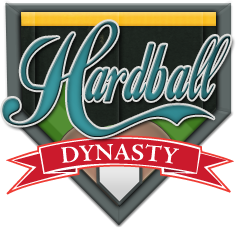My previous post regarding impartial trade evaluations was based on a Draft Value Chart that originated in the football universe, so it was admittedly a little bit flawed. However, thanks to FanGraphs Audio podcast Effectively Wild and the associated Facebook group, I have recently stumbled upon the website Baseball Trade Values. In addition to being super fun to mess around with on the subject of MLB hypotheticals, it also provides a nice model of how to assess trades here in Hardball Dynasty.
For those of you who didn't click the link above, here's the most important portion of the article that they've written explaining how they calculate a player's trade value: "On the surface, calculating trade value is relatively simple: Field value – salary = surplus ...What do we mean by 'field value'? (By the way, that’s our term. We don’t know if anyone else uses it.) It’s an estimate of how much that player is worth on the field."
They then go onto explain that they take the following items into consideration when calculating "field value":
1) Dollars-Per-WAR. They explain that they've figured out that MLB teams pay roughly $9M per WAR in Free Agency and use that as their baseline in calculations. However, in Hardball Dynasty, the maximum amount you can pay a Free Agent is $30M per season and the high end of the WAR spectrum is typically around 10 WAR in a given season, so here in HBD it would be more like $3M per WAR.
2) Projections. They use projections based on advanced models such as the ones on FanGraphs, which are likely more advanced than the system that I use. However, I do have a method for estimating a player's WAR value in Hardball Dynasty, so that's what I'll use for the projections in this system.
3) Inflation. Thanks to the constant $185M budget, this is not something we need to account for here.
4) Years of Control. This is pretty straight forward, with the exception of guys on rookie contracts. For those players, the idea is that they'd get arbitrated if their projected WAR is bigger than zero...but if it's negative, they'd get released and are considered under control up until the end of their rookie deal and not beyond. The dollars-per-WAR and projections generate a one-year total, so that total simply gets multiplied by the number of years left on a guys contract to estimate a total WAR projection for the player.
5) Injury Risk. They aren't very specific about how they mathamatically account for injuries in their formula, but lucky for us HBD has a health rating. I have added in an "injury multiplier" that is directly tied to the player's health rating. The total WAR projection from the years of controlled would be multiplied by this number.
6) Roster Risk. In their words "players who are out of options carry what we call roster risk, which is a negative adjustment to their field value. We apply a discount for players with that status. (Note that this is only true of players who are marginal – typically somewhere just above replacement value; stars or above-average regulars don’t have this risk.)" For the purposes of this exercise, I am going to apply this penalty to players who project to have single season WAR totals between 0 and 2 overall.
After those totals have been calculated, to find the "surplus value" you simply subtract the total amount of money the player is owed over the course of the contract from the total value that the formula produces. For minor leaguers, it's a somewhat simpler formula in that the years of control are eliminated (since there's no guarantee they'll make the majors.) Here's a look at the deal that I analyzed before using this new method:
To Louisville: Jared File ; Lance Williams
To Toronto: Pascual Arias ; $5M
Jared File: -3.91 projected WAR, 73 health rating, maximum roster risk (for negative value), position bonus for playing catcher = -7.71 "surplus" trade value
Lance Williams: 0.24 projected WAR, 85 health rating, medium roster risk, no position bonus = 0.81 surplus trade value
Pascual Arias: -3.93 projected WAR, 58 health rating, maximum roster risk, no position bonus = -11.79 "surplus" trade value
$5M cash: In a system that's evaluated in cash value, cash comes at face value = 5.00 surplus trade value
IN TOTAL: Louisville -7.71 + 0.81 = -6.90 "surplus" trade value // Toronto: -11.79 + 5.00 = -6.79 "surplus" trade value
Since there aren't any major leaguers in that (fair) deal above, I've decided to publish my evaluation of a trade offer from Milwaukee to me (Tacoma) to illustrate how that works:
To Milwaukee: John Tabaka, Khiry Russ, Nelson Olson
To Tacoma: Junior Ford, Dillon Corey
John Tabaka: -1.35 projected WAR, 82 health, maximum roster risk, no position bonus = -4.68 "surplus" trade value
Khiry Russ: 1.85 projected WAR, 2.5 years of control, 81 health rating, medium roster risk = 5.73 trade value - 1.081 million owed over rookie contract = 4.649 surplus trade value
Nelson Olson: -2.92 projected WAR, 45 health, maximum roster risk, no position bonus = -8.10 "surplus" trade value
Junior Ford: 3.24 projected WAR, 48 health, 1.5 years of control, no roster risk = 7.83 trade value - 9.9 million owed over next 1.5 seasons = -2.07 "surplus" trade value
Dillon Corey: -2.81 projected WAR, 49 health, maximum roster risk, position bonus for playing SS = -0.84 "surplus" trade value
IN TOTAL: Tacoma -2.07 - 0.84 = -2.91 "surplus" trade value // Milwaukee -4.68 + 4.649 -8.10 = -8.131 "surplus" trade value
bruinsfan911
DeveloperCommissioner of the fakest fake baseball league on the planet: Plumpy Rules!!!!111



0 comments:
Post a Comment